The "Barnum" Open 3rds
The Barnums were enormously distinctive and they served in quite a few different ways in GCR, LNER and BR days (covered separately). This part looks at the carriages themselves:
1 - Historical 2 - Designs
1 - Problems with the historical legacy
Four particular aspects stand out:
The nickname "Barnum" - only applied to the 60' 3rd Open stock designed in 1910 for excursion traffic - and not as has recently been published in BR Pre-Nationalisation Coaching Stock by Hugh Longworth for all subsequent 56' and 60' matchboard carriages (which had a different body shape; were built gangwayed and non-gangwayed; for express and suburban traffic; and included catering vehicles). This Tommy-rot also fails to recognise that most of the Barnum concepts were not used in the new matchboard designs which followed - they were a radically different animal for different applications (and I'm covering separately).
The profile - of the Barnums is often described as "slab-sided". In fact, there was a tumblehome, or as it's sometimes called, a turn-under, which can be seen on photographs, GCR drawings and Diagrams.
Construction - of the Barnums took place in 1910-11. It has been written in Main Line that:
"Between 1910-16 eight additional Third Opens were built to three designs based on the original Barnum design [but with] rounded exterior contours [and] greater leg room".
No. What actually happened is that completely different Opens were produced in 1911 and 1916 for different uses, nearly all shorter (56') - as Dining Cars with 48 seats arranged 2:1 to run with Restaurant Cars. There were many more doors; no end vestibules; and normal toilets. I've reproduced a Diagram and picture under Catering in the matchboard era in "GCR London Express Passenger Workings" (see link below).
Two illustrated tables - were published in J.G. Robinson, A Lifetime's Work by David Jackson, Oakwood Press, 1996, pages 128-129, claiming to show details of GCR carriages and formations. I have cleaned up and repaired both pages and show them here because it's relevant to the Barnums. Underneath I've put an enlargement and an analysis of what they claim to say:

These are the two pages from the book. As can be seen, the author offered no origin or source, which is unusual and not very helpful; they are unknown to me; and the content is suspect.

An enlargement of p.129 shows much that does not tally. (Click on the image for an enlargement):
To begin with, for an official document it is unusual to see the company's crests and an author's name. This I shall come back to. On the left is a table of what appears to be new construction of Robinson matchboard carriages for 1912, with technical details and number of each. To the right are schematic representations of train formations. For example:
EXCURSION - five identical formations of 7 carriages are shown, each comprising:
"3rd brake, 1st, 3rd, 3rd, 3rd, 3rd, 3rd brake"
The sketches show them as Open carriages, including the "FIRST", whose presence is most surprising - and in any case its details actually show a 1st/3rd composite, which would make more sense because it was not unknown for excursions to cater for a small number of 1st Class passengers. However, the GCR never built an Open Composite so this is fiction - as are the passenger capacities for all these carriages, almost double the actual numbers. The weights do not tally with the Diagrams either. All this was quoted on the GCR Diagrams. As regards the formations shown, they are nothing like GCR period photographs (see "In Service" part to follow shortly) which were:
- a mixture of carriage designs: open, side-corridor and even non-corridor - sometimes with a restaurant car - and only one case with a possible composite.
Then there's the number of carriages "Ordered" for the excursion sets. For 1911 - the numbers are: THIRD (2), THIRD BRAKE (2). None are shown as "Completed" for 1911 and 1912. A single formation is shown as described above. Underneath it is a 3-carriage formation: FIRST, THIRD, THIRD - which may have been for excursion parties in carriages added to a normally timetabled service, but is odd to see presented this way. For 1912 - the numbers are: THIRD (18), THIRD BRAKE (10), and FIRST (4). None are shown as "Completed" for 1912 and 1913. The same number of THIRD BRAKES appears in the five formations shown alongside. This is odd because only 6 Barnum BTOs were built.
Conclusions
I have not gone on to examine the other formations - for which the GCR offered fulsome detail in its own publications - because these two tables contain so many mistakes that the company would not have made. It comes across as fanciful work by an amateur and should be disregarded.
It's disappointing that so many errors have been published on this subject. The real Barnums were important historically for being the first excursion Opens with 64 seats arranged 2:2 - which became a standard format in LNER designs in the 1920s, '30s, '40s and then '50s in BR Mk.1s. Faults like this are misleading, especially when much source material is available as well as long-standing knowledgeable experts. I wonder why the GCR, with its cult following based on the London Extension, gets short-changed so much? Answers please on a postcard.....
2 - Designs
It helps to bear in mind that when it came to 3rd Class Open carriages there was a division between two types with seating arranged:
2:1 for use as dining cars alongside restaurant and kitchen cars
2:2 where the intended use was for excursion traffic.
In principle either could be used for either application (if not as satisfactorily, of course) and when the telegraphic codes were created, the LNER used "TO" for both types. In the carriage rosters the right choice could be covered by stating the number of seats, the 2:2 version having one third more. For a 60ft carriage it was TO(48) and TO(64), respectively. In BR days a difference in codes was finally established by adding a prefix "T" which the LNER had previously used to indicate the green & cream Tourist stock with 2:2 seating.
Robinson designed matchboard versions of both kinds and there were several catering types but the excursion one was covered by two Diagrams with thirty-eight built:
TO = 32
BTO = 6
These were to GCR Diagrams 5G1 and 5E1, respectively, with running numbers, again respectively, subsequently prefixed by the LNER with a "5":
89, 94-7, 153, 160, 238, 252, 396, 465, 482, 657, 661-2, 664-6, 668, 670, 684, 698, 700-2, 710-4, 718-9.
146, 155, 222, 695-7.
The GCR was not alone for other companies also built excursion-dedicated stock, albeit mostly after the Grouping of 1923 and the GCR's historical claim to fame arises from several novel features and, when introduced in 1910, a turning point on the GCR from conventionally panelled and beaded carriages to varnished teak matchboarding below the windows and, at the van ends, all the way up to the roof. The BTO and TO designs acquired the rather jolly nickname of "Barnum". However, except for the use of matchboarding, they were not precursors of the general service matchboard designs which began to be built from the following year, 1911. The Barnums of 1910 were in a unique class of their own.

It's convenient to show the Diagram for the BTO first because all the relevant stuff is displayed. Note how, although it's greatly over-stated in the drawing and not at all realistic (many carriage Diagrams exaggerated the body profile), there was no curved tumblehome below the waist: it was flat and vertical. The upper half was also flat but angled back almost imperceptibly, especially at the van end where it is almost impossible to see with the naked eye. This contributed to a rather boxy appearance and, some would say, "continental" or "American" appearance. This profile was not repeated: subsequent matchboard designs had a conventional outline with an elegantly curved tumblehome below the waist.
The narrow end vestibule - at both ends of the TO and BTO - was also not to be repeated. Indeed, Robinson spurned end vestibules with doors for all his future designs (except for a restaurant composite of 1913). In addition, all the doors opened inwards and, even more unusually, the passenger doors had no droplights, only fixed glazing, in four panes. This, too, was not to be repeated. In truth, the only new design feature that was continued was the use of teak matchboarding. It seems that Robinson wanted to make a statement with carriages for excursion use and cultivate the traffic, for which rickety old bangers on six wheels had been a staple for some time (as did Gresley some years later with his "Tourist" stock).
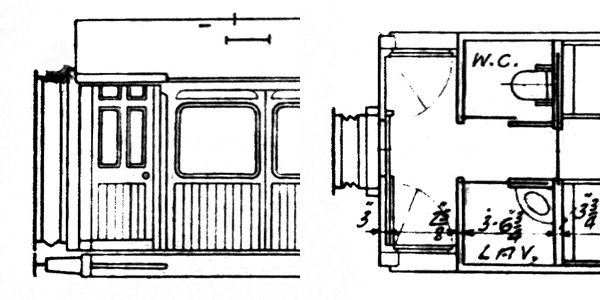
Click on the image for an enlargement
The 2:2 seat layout limited the space for a complete toilet with W.C. (water closet) and wash basin so, instead of providing a longer one, they were separated and placed on opposite sides of the corridor.
In the van end - single sliding doors were provided, which were alright if well maintained, but otherwise prone to stiffness. This concept had been introduced during the 1900s as an external feature of bogie vans and Robinson was to use again in his matchboard BG of 1913-14, but the "Barnum" BTO of 1910 was a complete one-off - it was the only passenger-carrying vehicle to be fitted with sliding doors and they were placed internally. After these episodes, the concept was abandoned altogether in favour of hinged doors. The end vestibule door for the guard was fitted with a droplight, but the ducket, which the GCR normally provided on both sides, was omitted. The guard was expected to stick his head out. No hand brake was provided either; it was a little spartan and with the sliding doors, probably draughty, too. By contrast, sliding van doors on the GNR were of the "plug" type which sealed better, but they too were eventually abandoned by Gresley who, after the Grouping, began to provide a heater as well. Conditions for the guard, often primitive at first, gradually got better.
The underframe layout - became the standard one for 60ft carriages, carried on Spencer 10'6" bogies with heavy journals. This was arguably a case of safe, over-engineering and 8ft bogies were used for 56ft carriages. In 1909, when the GNR had introduced a similar carriage length of 61'6", it had also fitted a longer bogie (10') but within a few years Gresley's 8'6" bogie was available and a heavy version was only used where it was really required. It's an interesting aspect of the thinking behind these "Barnum" opens and their intended use for cheap-fare excursion traffic.
Originally fitted with dual braking for use all over the country, the LNER began removing the Westinghouse brake in the very late 1920s.
Over the years other aspects of the design were modified and these are described under the photographs. Author's collection.
Click on the image for an enlargement
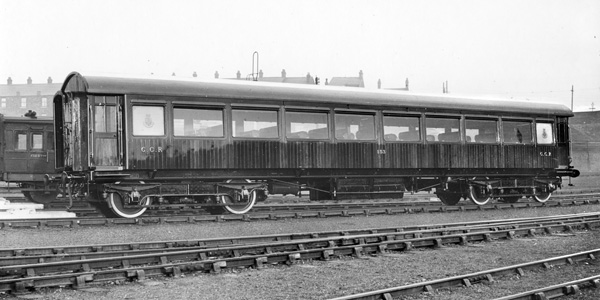
An official photograph taken in 1910 at Dukinfield of newly-built TO No 153. Originally some of the large windows were droplights and the nearest one can be seen lowered by a couple of inches. This was a grand feature which the GNR and LNER used in some of its 1st class carriages but in practice the ventilation was not so good and in the "Barnums" it was changed later. In the photograph, a combination of the play of light, fresh varnish and cleanness make a stunning impression but, alas, this did not last in service. One suspects that they weren't visited by the carriage cleaners as often as the main line trains. Photo: Gorton negative, Doncaster Dwg Office, author's collection.
Click on the image for an enlargement
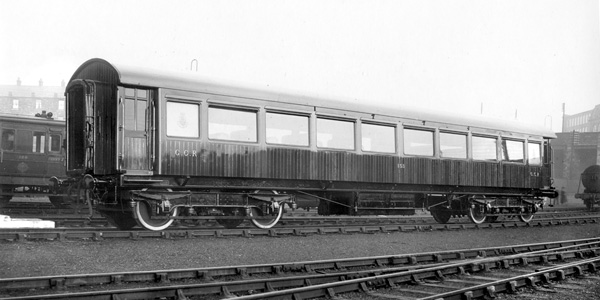
Another view of TO No 153 on the same day, which, from a lower and more end-on angle, isn't as flattering with the recessed end vestibule and its large grab handles contrasting with the rest and more streamlined body. The door handle is difficult to identify and looks like a conventional door knob! The British Standard scissors gangway shows well. Photo: Gorton negative, Doncaster Dwg Office, author's collection.
Click on the image for an enlargement

TO No 5700 in late LNER condition, seen in the 1940s, possibly at Mansfield. In the vestibule, the large grab handles are a different style, a variation when construction was spread over two years. Changes to the body and roof are described in the next two pictures. Photo: Author's collection.
Click on the image for an enlargement

Captured on 28th May 1949 is "Barnum" TO No E5712 at Gorton, recently shopped and still in varnished teak.
The ventilation in the body has been revised significantly. It looks like four of the windows have had their droplights sealed and the slim ventilation above the windows replaced by toplights with sliding lights. This modification would not have been undertaken lightly. The LNER recognised a lack of ventilation on hot sunny days in the corridors of Gresley designs where there were large fixed windows and began to increase the number of toplights in new construction from 1938 so this upgrading could have been carried out around the same time, or perhaps the problem was worse and a start was made earlier? I can't help thinking that a saving by not fitting roof ventilators proved to be a short cut that had to be rectified later.
On the roof, three changes were made: triple racks for destination boards were moved from the top of the body sides; a long curved rainstrip was added; and on the cornice above the doors, a slimmer rain deflector. Photo: Author's collection.
Click on the image for an enlargement
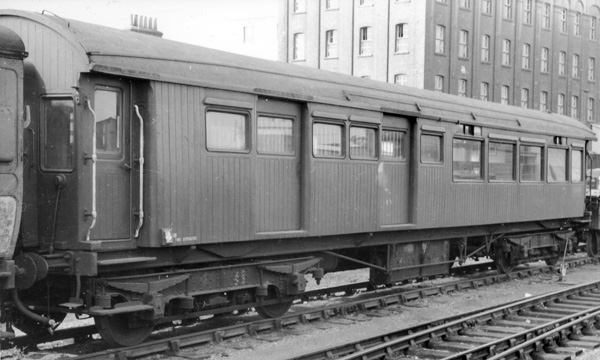
A marvellous view of a "Barnum" BTO is undated but the late BR lettering - the number appears to be E5695E - suggests the late 1950s and either maroon or possibly plain brown. Starting from the near end, the recessed end vestibule shows the different door provided for the guard with a droplight and a lever door handle. The depth of the sliding van doors lacks grace but the door handle is so small that one can only imagine that these were good, free-running fixtures. The lettering is partly concealed but there is a scribbled note on the Diagram which suggests that it would have read "Load 3 Tons Distributed".
The modified roof, windows and toplights with sliding ventilation are the same as on TO Nos 5700 and E5712 above. Once again, a full set for each window was not provided, only half of them. Photo: R.S. Carpenter.
Click on the image for an enlargement
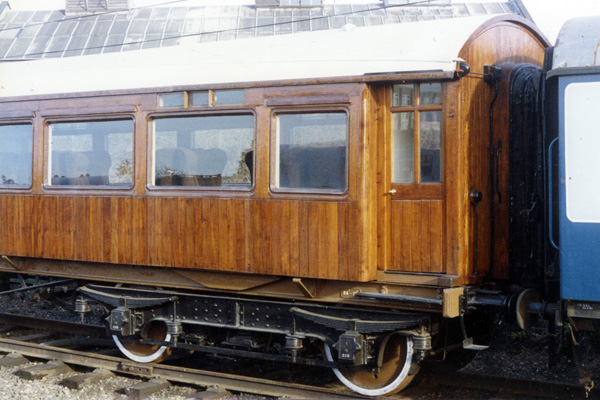
A preserved "Barnum" at Loughborough, (GCR No 664) shows how grand these carriages were when freshly built or overhauled. And such a tonic after all the black & white pictures which barely do them justice. The LNER replaced the lavatory end windows, originally etched with the GCR crest, by plain versions. Photo: Author's collection.
Click on the image for an enlargement
To sum up
Robinson's Barnums established a new approach for excursion traffic using newly-built carriages designed for the purpose with greater length and a simple, uncluttered open layout, only served by external doors in the end vestibules. There was no need for any more. Their use by the GCR is described in the second part: "In Service" and was not as has been imagined but, crucially, it led the LNER to develop dedicated trains of this kind of stock with catering added, and then design and market Buffet Tourist Trains, a sequence of developments that has not really been noted before. Over a longer period of time, side-corridor coaches were to be eclipsed by what might be called Barnum-style open carriages with 2:2 seating, tables in between, and doors only in the end vestibule.
v.3 12-10-22
GCR Barnums - in service: is here.
GCR carriages - 60ft matchboard: are here.
GCR carriages - 50ft London Suburban: are here.


